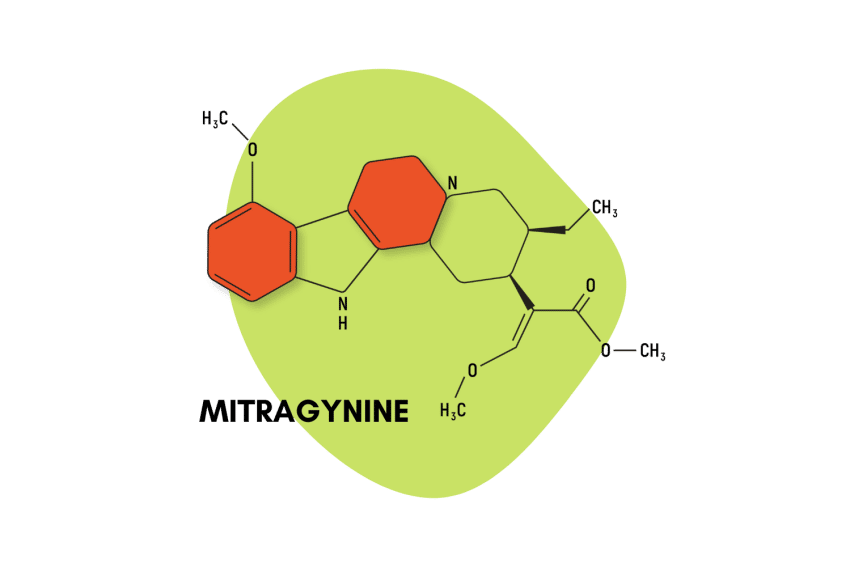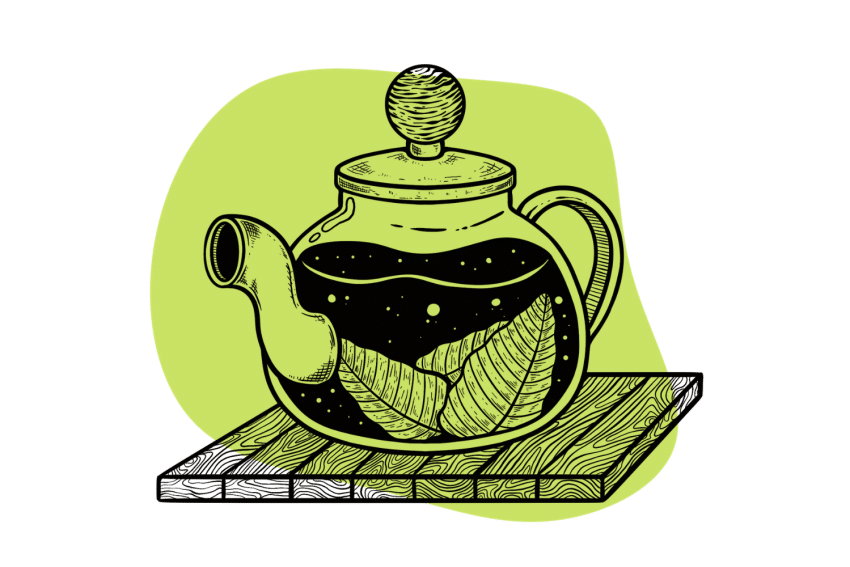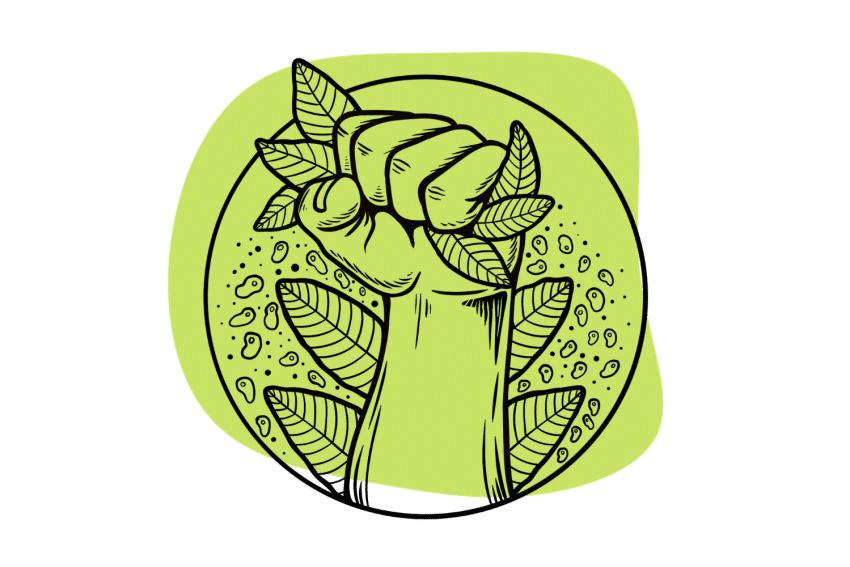Kratom for Pain Relief: How It Works, Why It’s So Popular, & Safety Concerns
Kratom might have what it takes to knock out your pain; just make sure you know how to use it.

One of the most common uses of kratom is pain relief, and the herb has gained massive popularity in the U.S. in the past few years as an alternative to opioids.
In this guide, we’ll discuss how well kratom relieves pain, its common side effects, why it works, and tips on using the herb safely.
How Does Kratom Relieve Pain?
Kratom is used by countless people in place of more addictive opioids, but many users don’t really understand how the substance works.
A few of kratom’s alkaloids — specifically 7-hydroxymitragynine — help reduce the perception of pain.
1. Kratom Binds to Opioid Receptors
Perhaps the most obvious way kratom affects our perception of pain is by binding to opioid receptors. Opioid receptors have a domain over the signals that travel through our central nervous system and get processed by our brains as pain.
Kratom is known to bind to three types of opioid receptors: alpha-opioid receptors, mu-opioid receptors, and delta-opioid receptors [1, 2].
These opioid receptors are located on nerve cells. When chemicals — like opioids or kratom’s alkaloids — bind to them, they restrict the signals that can travel through the nerve and also affect some neurotransmitters.
Changes in the nerve’s firing capacity and the inter-neuronal chemistry cause what we perceive as pain relief. In essence, the pain signals traveling through your body are interrupted by the alkaloids before your brain can process them as pain.
2. Kratom Creates a Surge of Dopamine
A bump in dopamine is just one of the chemical changes created when kratom’s alkaloids bind to those opioid receptors. Specifically, alkaloids binding to mu-opioid receptors produce greater volumes of dopamine in the brain’s ventral tegmental area (VTA) [3].
Dopamine is the primary neurotransmitter involved in our body’s pleasure-based reward system. When dopamine levels increase — whether that occurs because of something you do (like exercise) or a compound you consume (like kratom) — the brain processes a positive event. As a result, we feel good.
An increase in dopamine doesn’t directly affect pain signals, but it does have an impact on our perception of it.
3. Kratom Is An Agonist of GABA Receptors
Kratom’s alkaloids also have an agonistic effect on GABA receptors [4].
GABA is a neurotransmitter that’s linked to sedation of the central nervous system. It’s the primary neurotransmitter that is affected by benzodiazepines and depressants. When kratom’s alkaloids bind to GABA receptors, neurotransmitter levels increase and lead to a slowing of the CNS.
Ultimately, higher levels of GABA mean fewer signals travel through the CNS as a whole. Fewer signals, in general, mean fewer pain signals, so a bump in GABA can lead to some pain relief.
The GABA-ergic effects of kratom’s alkaloids lead to sedation and drowsiness, which can help users fall asleep when they otherwise might not be able to because of pain. GABA also relaxes muscles, so kratom can reduce muscle and joint-related pain [2].
4. Kratom Has Anti-Inflammatory Actions
Studies show mitragynine can inhibit mRNA expression of COX-2, cyclooxygenase, the enzyme that helps convert arachidonic acid to inflammatory prostaglandins (PGs) [5, 6].
Common non-steroidal anti-inflammatory drugs (NSAIDs) are COX inhibitors, and even more interestingly, COX-2 inhibitors may have fewer gastrointestinal side effects. [7]
The alkaloid also significantly reduced TRPV-1 expression in rats [8]. The TRPV-1 receptor plays a role in many cellular and physiological processes and detects things like temperature and chemical stimuli. Researchers target this receptor in an effort to come up with new pain-relieving drugs [9].
Is Kratom An Opiate?
Kratom’s effect on brain chemistry and its interactions with opioid receptors usually get people wondering if kratom is actually an opioid.
Technically, kratom is an atypical opioid — it has opioid and non-opioid mechanisms and comes with fewer side effects [10].
Kratom is a stimulant, and opioids are all central nervous system depressants. Because kratom acts on more than just opioid receptors, it has a wider range of effects.
Even though kratom provides pain relief to most users, the extent of the relief is less significant than you’d expect from an opioid.
Finally, opioids have a high risk of addiction, misuse, and abuse. In contrast, kratom has a relatively low risk of addiction and dependency — partly because it’s less potent and partly because of how it works. Only around 6% of lifetime kratom users report severe withdrawal symptoms when quitting [4].
The active ingredients in kratom are a group of about 67 alkaloids. Roughly 18 of these alkaloids make up the vast majority of the total alkaloid content and account for most of its effects.
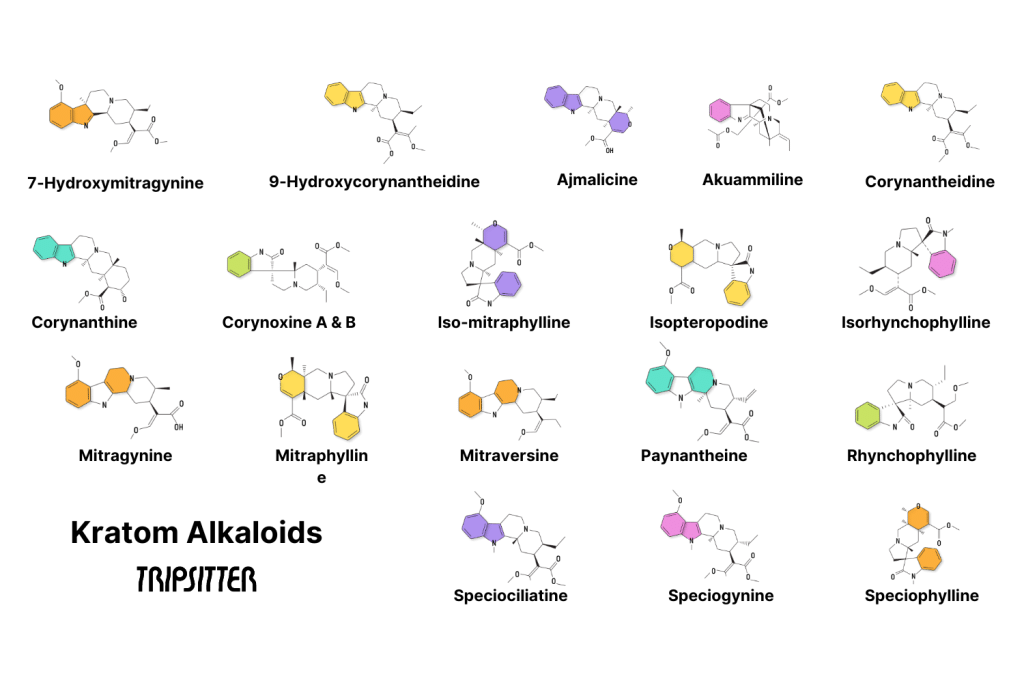
The Risks of Using Kratom for Pain
Here is where the controversy lies.
As you can see, kratom has a lot of therapeutic potential. But that also means it comes with risks.
Do the risks outweigh the bad? The research so far doesn’t seem to imply that. In fact, kratom is generally safe, especially when you look at all it does. Unfortunately, kratom can seem a lot scarier if you don’t have the facts — which is why it ends up banned.
It’s not foolproof, though, so here are the biggest dangers to be aware of — this is crucial since most of the problems with kratom come with larger doses.
Smaller, infrequent doses rarely cause a problem, but it’s not usually possible to severely limit the amount when you’re using it for pain. When using kratom for pain, it takes a greater degree of diligence — and, ideally, a doctor’s guidance.
1. Side Effects
Most of kratom’s side effects are due to taking too much, but they fade as the effects wear off and aren’t usually severe.
- Vomiting
- Nausea
- Dehydration
- Headaches
- Changes in mood; irritation, etc.
- Constipation
- Anxiety
- Loss of appetite
There’s no clear answer on long-term side effects yet, but people in Southeast Asia have been using it for hundreds of years, seemingly with no problems. However, kratom can possibly cause liver, kidney, and heart problems, so avoid it if you have underlying health issues. [11]
2. Addiction
Many people fear kratom because they think it’s an easily accessible opioid that will deepen the opioid crisis.
It’s true that kratom is addictive, but not in the same way as traditional opioids like morphine, OxyContin, or hydrocodone. It’s easy to become very addicted, very quickly to these, and the withdrawal can be horrible — even dangerous. [12]
A recent review (2023) of the available studies concluded that kratom addiction was more likely with long-term, heavy use, but moderate use did not tend to lead to significant withdrawal symptoms. However, this wasn’t consistent, as many people using large amounts of kratom for an extended time never faced symptoms.
Withdrawal is similar to opioid withdrawal — runny nose, muscle pain, diarrhea, depression, etc.—but most people manage to get through it on their own, usually with minimal disruption to their daily lives. [13]
3. Drug Interactions
You’ve likely heard horror stories of people dying from overdosing on kratom. This isn’t the whole story, though — in almost every instance, other drugs were involved, with opioids at the top of the list.
It’s not just illicit drugs or opioids you have to be careful with. Kratom inhibits CYP2D6 and CYP3A enzymes — the same enzymes that metabolize many other substances [14].
It also inhibits P-glycoprotein, a transporter that pumps xenobiotics (any compound that comes from an external source) out of cells, keeping them from being absorbed or crossing the blood-brain barrier (BBB). It’s essentially in charge of how they’re distributed and eliminated.
If you take prescription medications or supplements, talk to your doctor before using kratom. Never combine it with illicit drugs or substances that affect your central nervous system.
4. Adulteration & Contamination
The laws surrounding kratom are non-existent in most places, so the responsibility falls on you to make sure what you’re buying is safe and high-quality.
Anyone can package kratom and sell it, and sometimes these products contain things you don’t want, like salmonella or other drugs.
Make sure you buy only from reputable companies — look for ones that test their kratom through third-party labs and are open about who they are.
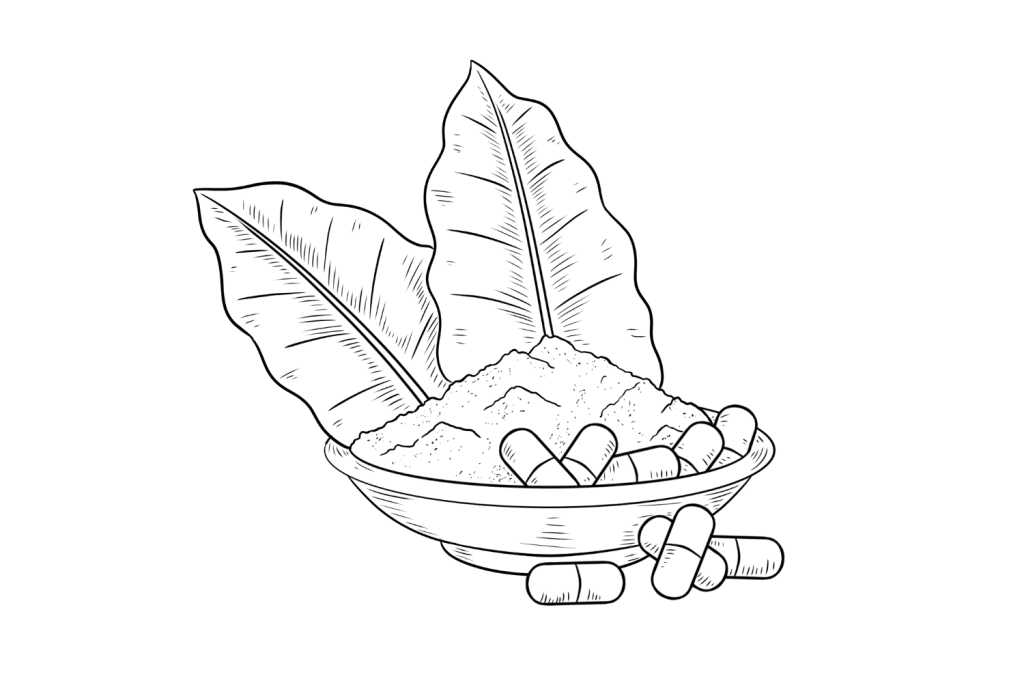
Is Kratom Safe for Pain Relief?
Because of the risks involved with kratom use, many people fear it, assuming it’s too similar to opioids. However, most people never experience addiction or dependence — or even its side effects [13].
The key is to use it responsibly, much like how you’d use acetaminophen: use only when necessary, use the smallest amount possible, and avoid using it daily.
One review of the literature found that regular kratom users in Southeast Asia, where the plant is native, were more likely to suffer from extreme withdrawal symptoms than those in the West. Only 2% of Western users developed moderate-to-severe kratom-related substance use disorders, and these incidences were most common with high doses and very frequent use. [15]
Another review found there are far more complications due to kratom use in the West and concluded this is due to a few factors. One, it’s often combined with other substances; two, products are often adulterated. [11]
With a little diligence, kratom can be a good option for mild to moderate pain relief, and for some, it even helps treat and manage severe pain.
How Do You Use Kratom to Relieve Pain?
User reports indicate that kratom is significantly more powerful than ibuprofen or acetaminophen. Research shows one of kratom’s main alkaloids, 7-hydroxymitragynine, is more potent than morphine when it’s isolated [1]. As a whole, it’s not nearly as potent as opioids.
It’s hard to quantify how well kratom treats pain, but most users find comfort when dosing correctly. It’s certainly a better option than prescription painkillers.
Considering the dangers of prescription pain relievers, kratom can certainly be worth trying out; just talk to your doctor first.
If you decide to try it, there are a few things you should know first. Check out our article on how to use kratom for pain for more details.
1. Kratom Dosage for Pain
Kratom is a unique substance because it is heavily dose-dependent. Taking a small or large amount of a single strain can yield wildly different effects. As such, it’s important to get your dosing right if you want to use the herb as a natural pain reliever.
In general, moderate to large doses are more appropriate for alleviating pain.
Use the below guidelines to get an idea of where your dose should fall:
- 3 to 4 grams — For mild pain
- 4 to 6 grams — For moderate to severe pain
- 6 to 8 grams — For severe pain
The dose you take should be determined by the level of pain you’re experiencing, although it’s a good idea, as with any psychoactive substance, to “start low and go slow.”
2. Kratom Strains for Pain
While the dose is most important, the strain matters, too.
For the best pain relief, choose a red strain — Red Bali is a favorite among users. Red kratom strains tend to have more 7-hydroxymitragynine, the potent morphine-like alkaloid. However, these are also more sedating. If you need to stay awake, try a green strain or mix a red with a green or white strain to balance the relaxing effects.

Wrapping Up: Why Kratom Is Such a Popular Pain Reliever
Kratom is a popular solution for relieving pain because it’s widely available, currently legal in most areas, and mimics the pain-reducing effects of opioids. Additionally, it’s considered far safer than taking prescription painkillers, and it has a lower risk of addiction, according to most experts.
If you’re looking to use kratom for pain relief, it’s best to take a red or green strain that has a high concentration of the alkaloid 7-hydroxymitragynine. Some common recommendations include Red Maeng Da, Red Borneo, Red Bali, Green Maeng Da, and Green Malay kratom.
Subscribe For More 🍄
References
- Matsumoto, K., Horie, S., Ishikawa, H., Takayama, H., Aimi, N., Ponglux, D., & Watanabe, K. (2004). Antinociceptive effect of 7-hydroxymitragynine in mice: Discovery of an orally active opioid analgesic from the Thai medicinal herb Mitragyna speciosa. Life Sciences, 74(17), 2143–2155. https://doi.org/10.1016/j.lfs.2003.09.054
- Suhaimi, F. W., Yusoff, N. H. M., Hassan, R., Mansor, S. M., Navaratnam, V., Müller, C. P., & Hassan, Z. (2016). Neurobiology of Kratom and its main alkaloid mitragynine. Brain Research Bulletin, 126, 29–40. https://doi.org/10.1016/j.brainresbull.2016.03.015
- Kosten, T. R., & George, T. P. (2002). The neurobiology of opioid dependence: Implications for treatment. Science & Practice Perspectives, 1(1), 13–20. https://doi.org/10.1151/spp021113
- Ismail, I., Wahab, S., Sidi, H., Das, S., Lin, L. J., & Razali, R. (2019). Kratom and future treatment for the opioid addiction and chronic pain: periculo beneficium?. Current drug targets, 20(2), 166-172.
- Utar, Z., Majid, M. I., Adenan, M. I., Jamil, M. F., & Lan, T. M. (2011). Mitragynine inhibits the COX-2 mRNA expression and prostaglandin E₂ production induced by lipopolysaccharide in RAW264.7 macrophage cells. Journal of ethnopharmacology, 136(1), 75–82.
- Hassan, Z., Muzaimi, M., Navaratnam, V., Yusoff, N. H., Suhaimi, F. W., Vadivelu, R., … & Müller, C. P. (2013). From Kratom to mitragynine and its derivatives: physiological and behavioural effects related to use, abuse, and addiction. Neuroscience & Biobehavioral Reviews, 37(2), 138-151.
- Zarghi, A., & Arfaei, S. (2011). Selective COX-2 Inhibitors: A Review of Their Structure-Activity Relationships. Iranian journal of pharmaceutical research : IJPR, 10(4), 655–683.
- Mat, N. H., Bakar, S. N. S., Murugaiyah, V., Chawarski, M. C., & Hassan, Z. (2023). Analgesic effects of main indole alkaloid of kratom, mitragynine in acute pain animal model. Behavioural Brain Research, 439, 114251.
- Jara-Oseguera, A., Simon, S. A., & Rosenbaum, T. (2008). TRPV1: on the road to pain relief. Current molecular pharmacology, 1(3), 255–269.
- Raffa, R. B., Pergolizzi, J. V., Taylor, R., Ossipov, M. H., & NEMA Research Group. (2018). Nature’s first “atypical opioids”: Kratom and mitragynines. Journal of Clinical Pharmacy and Therapeutics, 43(3), 437–441. https://doi.org/10.1111/jcpt.12676
- Prevete, E., Kuypers, K. P. C., Theunissen, E. L., Esposito, G., Ramaekers, J. G., Pasquini, M., & Corazza, O. (2023). Clinical Implications of Kratom (Mitragyna speciosa) Use: a Literature Review. Current Addiction Reports, 1-18.
- Hartley, C., Bulloch, M., & Penzak, S. R. (2022). Clinical pharmacology of the dietary supplement kratom (Mitragyna speciosa). The Journal of Clinical Pharmacology, 62(5), 577-593.
- Henningfield, J. E., Chawarski, M. C., Garcia-Romeu, A., Grundmann, O., Harun, N., Hassan, Z., McCurdy, C. R., McMahon, L. R., Sharma, A., Shoaib, M., Singh, D., Smith, K. E., Swogger, M. T., Vicknasingam, B., Walsh, Z., Wang, D. W., & Huestis, M. A. (2023). Kratom withdrawal: Discussions and conclusions of a scientific expert forum. Drug and alcohol dependence reports, 7, 100142. https://doi.org/10.1016/j.dadr.2023.100142
- Tanna, R. S., Cech, N. B., Oberlies, N. H., Rettie, A. E., Thummel, K. E., & Paine, M. F. (2023). Translating kratom-drug interactions: from bedside to bench and back. Drug Metabolism and Disposition, 51(8), 923-935.
- Yang, B., Yi, S., Zhang, R., Abdullah, B., & Leong, M. F. I. (2023). Adverse Psychological and Therapeutic Effects of Kratom (Mitragyna speciosa) Use: A Systematic Review. Malaysian Journal of Medicine & Health Sciences, 19(5)

